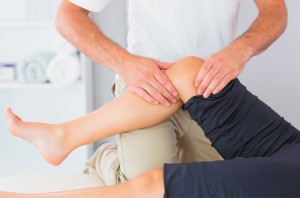By David Light, PT, DPT, MTC
Director, Regional Physiotherapy Centre School of Massage Therapy
 Iliotibial Band Syndrome (ITBS) is one of the most common overuse injuries among runners. It can also be seen in cyclists, hikers and weight lifters, particularly with heavy squats but is one of the leading causes of lateral knee pain in the running population. ITBS can also be known as ITBFS, Iliotibial Band Friction Syndrome although the exact mechanics of the injury / condition are well debated in the research. The iliotibial band is a thick band of fascia extending from the outside of the pelvis, over the hip and knee, and inserting at the knee. The band is a key knee stabilizer during running, as it moves from behind the femur to the front of the femur during activity. The continual rubbing of the band over the lateral femoral epicondyle, combined with the repeated flexion and extension of the knee during running is thought to be the source of inflammation. However, the root cause may stem from hip abductor weakness. If the gluteus medius, or other hip abductors are weak, the tensor fascia latae compensates resulting in an overworked TFL along with a tight ITB.
Iliotibial Band Syndrome (ITBS) is one of the most common overuse injuries among runners. It can also be seen in cyclists, hikers and weight lifters, particularly with heavy squats but is one of the leading causes of lateral knee pain in the running population. ITBS can also be known as ITBFS, Iliotibial Band Friction Syndrome although the exact mechanics of the injury / condition are well debated in the research. The iliotibial band is a thick band of fascia extending from the outside of the pelvis, over the hip and knee, and inserting at the knee. The band is a key knee stabilizer during running, as it moves from behind the femur to the front of the femur during activity. The continual rubbing of the band over the lateral femoral epicondyle, combined with the repeated flexion and extension of the knee during running is thought to be the source of inflammation. However, the root cause may stem from hip abductor weakness. If the gluteus medius, or other hip abductors are weak, the tensor fascia latae compensates resulting in an overworked TFL along with a tight ITB.
ITBS symptoms range from a burning sensation just above the knee, to swelling or thickening of the tissue in the area where the band moves over the femur. The stinging sensation just above the knee joint is felt on the outside of the knee or along the entire length of the iliotibial band. Pain may not occur immediately during activity, but may intensify over time. Pain is most commonly felt when the foot strikes the ground, and pain may also persist after activity. Pain may also be present below the knee, where the ITB attaches to the tibia.
Treatment for ITBS is typically conservative. Initially, in the acute stage, rest or relative rest is critical. During lighter activity, using superficial heat and stretching prior to exercise is recommended. However, if the injury is severe, avoiding heat initially would be prudent. Post activity, ice packs or ice massage will help to decrease soreness. Physical therapy treatment in the acute stage may include modalities such as phonophoresis or iontophoresis in addition to cryotherapy to decrease the inflammation.
Once out of the acute phase, there are a number of options available to treat ITBS, massage being one of them. The aim of sports massage would be to release tension in the muscle and fascia and stimulate blood flow to accelerate healing. The ITBS actually begins as the tensor fascia latae muscle and has attachments at the origin from the gluteus medius, gluteus minimus and vastus lateralis. With this condition, there can be significant involvement of the gluteus maximus as well. Massage therapy to the muscles that make the ITB tight can go a long way toward alleviating the symptoms and helping to prevent reoccurrence. Regular deep tissue sports massage performed by a licensed massage therapist can help avoid future muscle strains and inflammation by increasing flexibility. The application of myofascial release has also proven effective in restoring flexibility to hypertonic tissue. Specialized techniques to further lengthen the IT Band are useful as well. Given ITBS can become an ongoing problem, it is well worth the time to find a licensed massage therapist with considerable experience treating sports injuries in order to obtain the best outcome.
Check Also
Physical Therapy for the Brain
Have you noticed you have difficulty hearing your family and friends in a noisy restaurant? …
 South Florida Health and Wellness Magazine Health and Wellness Articles
South Florida Health and Wellness Magazine Health and Wellness Articles




